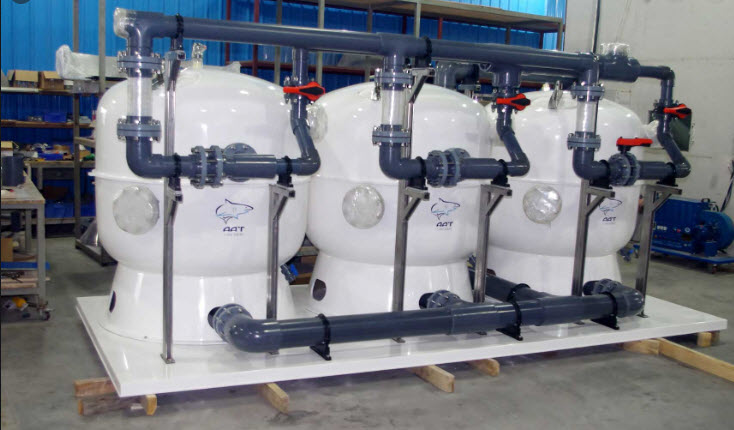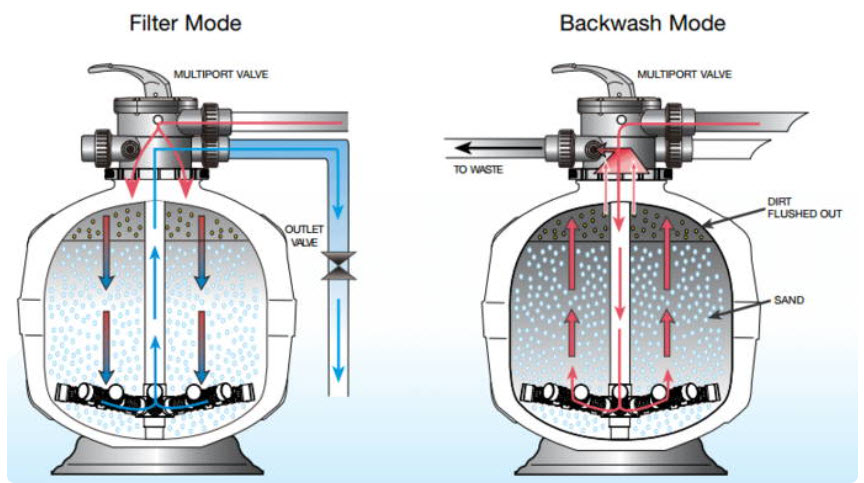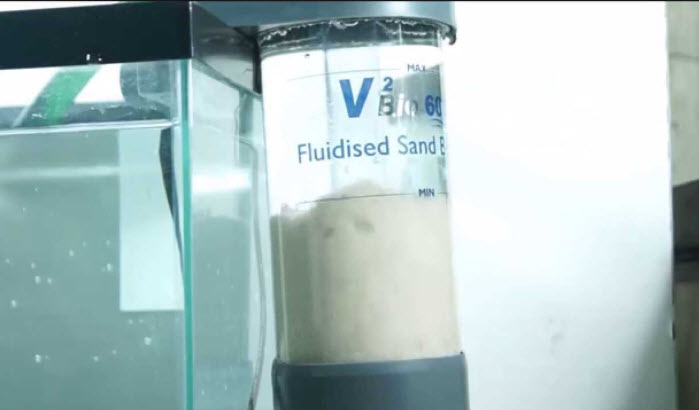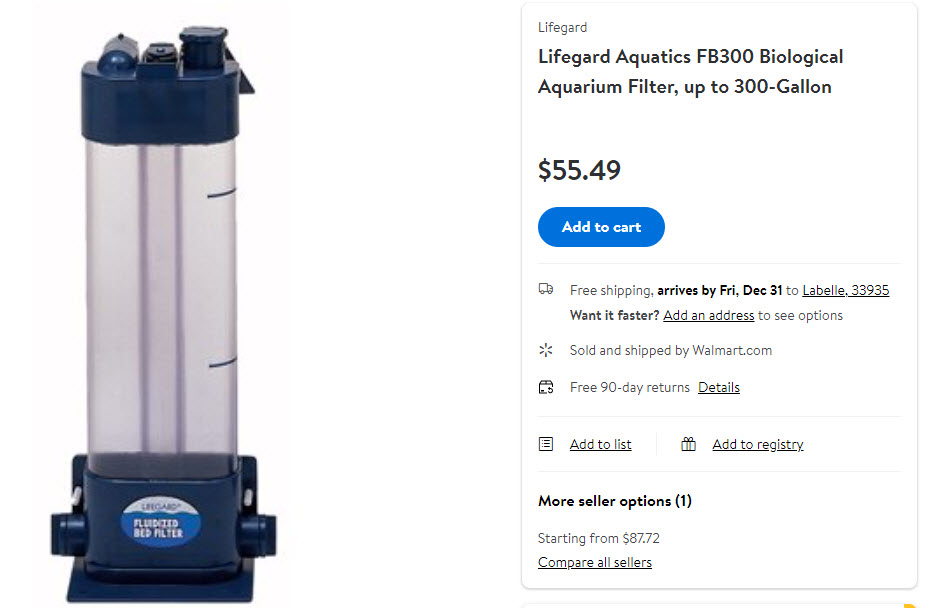
Stationary Sand Bed Filters
Public aquariums typically use very large stationary sand filters to do the mechanical and biological filtration. Because the public aquariums use a small sand volume to fish weight ratio (.e. a lot of fish for a small amount of sand), they must backwash these filters daily, typically on a computerized automatic cycle. The biological filtration is done very efficiently by a thin hard biofilm which is created on the sand particles.
Because the sand particles are so small the surface area of these filters is simply staggering. A well set up sand filter will have two to four times the capacity of an equal volume of fluidized K1 bed. But there are no designs of these stationary sand beds that will work for the aquarium.
In Tank Stationary Sand Beds
Cory from Aquarium Co-op found a huge wholesale fish facility in the Netherlands that had the backwall of each aquarium (about 1,000 aquariums, all identical!) a sand bed where a relatively small flow of water flowed down through some filter floss, up through an air tube, then down through a bed of very coarse (2 millimeter?) grey sand that looked like blasting media to me, then back up through another tube into the aquarium. The sand filters were low flow and never cleaned.
This system unfortunately requires that the water level in the aquarium only be at roughly 75% of capacity. Not something that will work for a decorative aquarium. But it has given me an idea for an innovative sand bed filter that would work on a decorative aquarium. I’m working on it.
Pool Sand Filters
Stationary sand filters are used for pools. These are cheap, $250 to $350 for the unit without the pump.

The problem with these pool sand filters comes when the water flow hits the fabric that keeps the sand in the filter. Pool water has chlorine and thus doesn’t clog this fabric with biofilm. Aquarium water will clog this fabric pretty rapidly with bacterial biofilm and the flow will stop.
Modified Pool Sand K1 filter
Rachel O’Leary came up with the idea of taking a pool sand filter casing , removing the sand and the fabric filter, and filling it with K1 media. Attach an external aquarium pump. This is a very good idea. It gives one a very low cost, high capacity filter, especially if one can find a used unit at a pool supply store. Note that K1 is an excellent stationary filter media as shown by testing. K1 does not have to be fluidized to work well. Filling the unit with plastic pot scrubbers would also work very well.
The inlet and outlets of the pool sand filter will have to be modified to make quarter inch holes act as the media retaining strainer. If the fabric that comes with a pool filter is used bacteria will clog it up with biofilm in short order.
Small Aquarium Fluidized Bed Sand Filters
There are some companies which sell a third type of sand filter, a small fluidized sand bed. These were considered the optimum aquarium filter until K1 fluidized bed media came along. K1 is very superior to sand as a fluidized media not because it is a better biofilter (it isn’t) but because K1 fluidized bed doesn’t require an engineering degree to install it and keep it running.
At the current time the only sand filter I can find used for aquariums in the USA is the Lifeguard Fluidized bed sand filter.

The following comment from a user of this system, Robert E Holt, is pertinent:
“The Lifeguard, once installed seems to work well. Plumbing it was a bit of a pain, and I had an issue with it leaking initially, but have not had a problem keeping the sand suspended. The biggest problem is, it is designed with too many options. There are 4 different locations for hose connectors. and a valve on top to adjust the flow. Each of these openings offer opportunities for the unit to leak. I found the valve to be useless and a major source of leaks.
I almost gave up on it, but was able to seal the valve, in full open position, as well as the other connections, and install ball valves on the inlet, in order to adjust the flow. In order to not restrict the flow on the canister filter, I also installed a bypass, with another ball valve. The canister filter is filled with 30 ppi foam, providing additional bio filtration, and acting as a prefilter for the sand filter.
The system has now been running for 2 months with no apparent loss of sand. Ammonia and Nitrite are always 0 and the water is crystal clear. The plumbing is a bit of an eyesore, and I am not sure I would go to the trouble again, but now that it is in place, there is no recurring maintenance and it seems to be doing its job.”
I.e. only consider a fluidized bed sand filter if you like “fiddling” with a very complex system. Note also that this hobbyist is using a foam filled canister as a “prefilter” to the sand filter. So is the crystal clear water because of the sand filter or is it because of the canister filled with foam? Good question!
.

.
But note that this is a very good filter at a very reasonable price. It will filter a lot of fish load very efficiently. It is two to three times more efficient than fluidized bed K1 sumps and easily ten times more efficient than a canister. But note the small size of the unit.
This filter is also easily converted to a K1 fluidized bed simply by plumbing in an air stone, with some loss in efficiency as the K1 is not as good as sand as a media. And it should be noted there are several “do-it-yourself” designs of this sand filter on YouTube. They are all way too complex for my tastes. In my experience, the more complex any device is, the more unreliable it becomes. I like good old “KISS” designs, “keep it simple stupid”.
.
I do NOT recommend fluidized sand bed filters!
.
They are NOT simple to operate.
Also note that the designs I see on YouTube of these sand filter devices all use PVC plumbing that has several glaring errors. First of they do not abrade the joints nor do they use primer. Then they do what are called “butt” joints, the pipe is cut so small the fittings butt up against each other. And they wrap their Teflon Tape in the wrong direction.
These errors will produce leaks. Indeed, the first go around for one of these YouTube video makers had leaks all over the place. Which this person “fixed” by doping on huge quantities of adhesive. aahhhahahmmm … This person is an ……. OK … OK … I won’t use that descriptive term.
Return to Filters Menu
Return to Miscellaneous Filters Menu
.
Aquarium Science Website
The chapters shown below or on the right side in maroon lead to close to 400 articles on all aspects of keeping a freshwater aquarium. These articles have NO links to profit making sites and are thus unbiased in their recommendations, unlike all the for-profit sites you will find with Google. Bookmark and browse!
.

Russ says
I tried the Lifegard FSB filters a long time ago. I never had problems with them leaking, but the problem I did have was that if the output isn’t submerged under the water and it loses power, some of the water inside the unit gets siphoned back into the tank through the input (despite the check valve they include). That little bit of reverse flow results in sand getting sucked up into the input tube. Once that happens, it will never start again until after you spend an hour holding it horizontally while sloshing water through it to break up the sand clog. I even tried hooking it up to a big high pressure pump, but sand in that narrow tube is like trying to push concrete through it. That being said, this is a problem regardless of who made the filter. It is inherent to all FSB designs. There are a few solutions: rely on a check valve (which WILL fail eventually), rely on mechanical filter media to prevent the sand from going “out the in” (which will eventually clog and need back flushed), or the BEST SOLUTION is to set it up so the input and the output are ALWAYS submerged. Preferably set it up so the input is above the output so if the water level does drop, the water siphons out in the correct direction.
Daniel says
I did something similar with my A frican cichlid tank. I had a 6 gallon stainless steel cannister (from Alibaba – big mistake, long story) filled with static K1 and V2max bio 1500 fluidised reactor in series. It ate up loads of ammonia etc. (although that’s not hard) but never got completely clear water. The trouble I had I think was flow rate – 1.5 volumes/hour isn’t quite enough to give you the fabled crystal clear water, but I found that if I put more flow through the sand over fluidised. Sand size is v important – too small or different sizes (like kids play sand) and it blows out all over the aquarium. Too big and it doesn’t fluidise properly without a bigger pump. Pool filter sand is probably best being a uniform 0,5mm/40mesh. Aquarium sand tends to be too big.
Also, the V2 max from TMC has crappy hose barb screw nuts which do not prevent the plastic creeping and are prone to leaks. Which happened. I still use it, but I eventually made a crude sump out of a plastic tote with static K1, and put the sand filter inside with a small underwater powerhead running it. Now my water is super clear, and I might retire the cannister. I have to say though, that in terms of the time/money/embuggerance triangle I would rather have just bought two FX6s and filled them with Poret(TM) foam.
I do agree with the overall thrust of this page though in that fluidised sand is technically unbeatable as a filtration method, but too complicated and annoying for most people, who I think are more into fish than filtration tech. Takes all sorts to make a world.
Christian says
I didn’t have the space for a sump so I gave the sand filter a try and still using it. Intake hose goes to a UV sterilizer, to a canister filter with one layer of course foam and the rest static K1, to a media reactor with gravel on the bottom and pool filter sand fluidized, and finally to aqueon canister polishing unit filled with floss (basically a HOB with no motor just a port for the output tube). I’ll fully admit this is way more complicated and risky for leaks but I have crystal clear water in a overstocked 75g discus tank using only a cabinet sized space.
Daniel says
I’m less pessimistic on sand filters. For sure, these aren’t plug in and forget like a cannister, they have to be tuned for flow in the first few weeks (but so does a sump of course). No-one is interested in making these anymore (no profit in it). But there are plenty of media reactors made for the salty people which could be repurposed into a fluidised sand bed quite easily. They’re not all good (won’t do brand names but they go from crap to excellent), and many are quite small (1-1.5 litres) so they even with the increased efficiency of sand wouldn’t get up to the performance of a 15 galllon sump, but they do work better than even the largest cannister and easy to set up. No plumbing skills or engineering degree required! Best part though, they are completely silent (with a good pump) and zero maintenance.
I wouldn’t rely on one for my only filter, but you could connect one or more in series with a small foam prefilter, and have a decent setup for little cost. You could even put it on the end of your v expensive cannister filter and massively increase the effective surface area for under a hundred bucks. Experimentation required of course to get flows right without blowing sand everywhere but it can be done.
Morgaine says
I’d really love a more scientific/in-depth explanation of how these filters work. I’m having trouble finding any resources that give me this explanation on a college level. If you can find any good resources on this, please let me know!
Jason G says
I have been using fluidized bed filters for over 15 years and they are wonderful. I have a 300 gallon salt tank with a 23 year old whitespotted bamboo shark that makes a mess. Unfortunately the aquatic ecosystem filters I brought are no longer available and the lifeguard filters are garbage- they leak. When not leaking they work well! Also the power outage issue is a myth. No worse than any other filter.
Dave says
In reply to Glen …. I don’t know. I’ve never tried it.
Glen Krakow says
Will reverse flow under gravel filter with a top layer of sand work to prevent sand infiltration under the filter? This is similar to natural springs in Florida.
I currently have 3” layer of sand, and 1” layer of akadama soil and 1/2” of gravel over my plate with a normal flow for one year but I have no idea what’s under the plate.